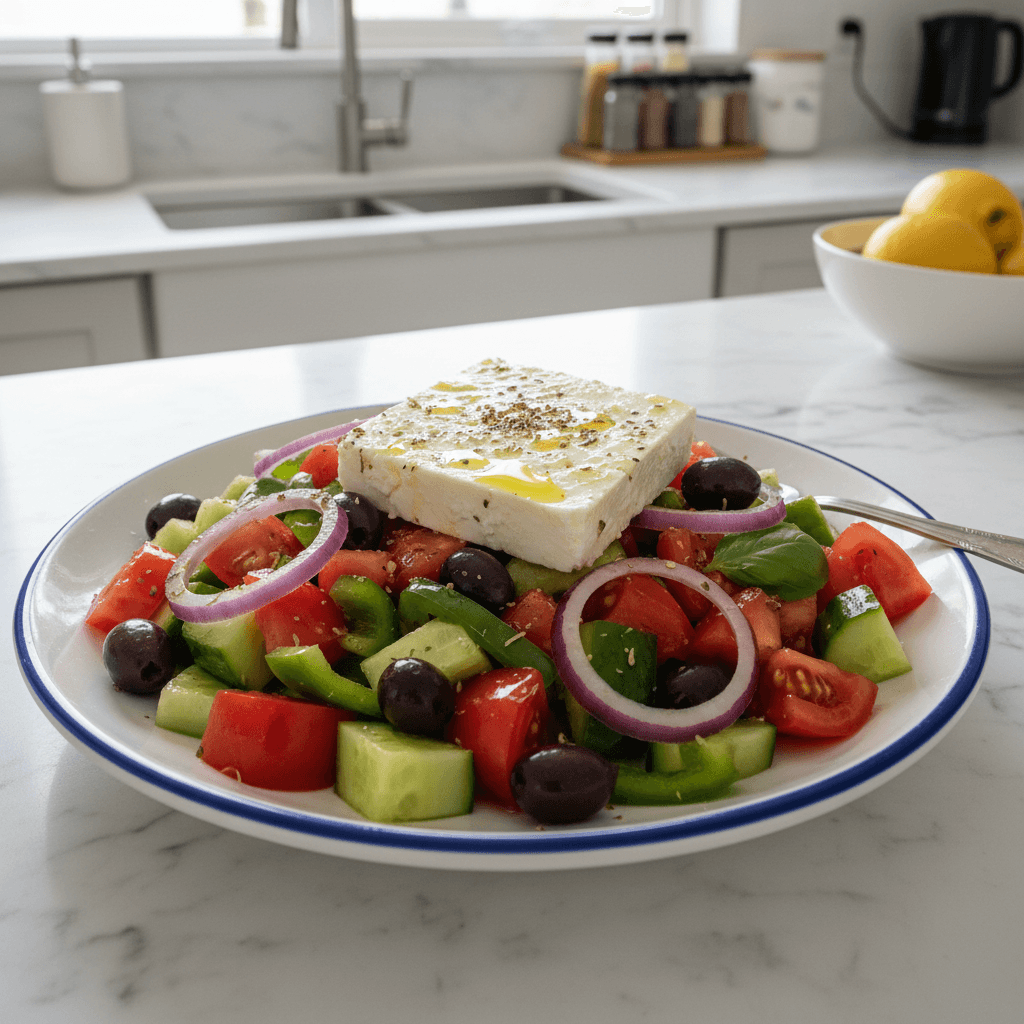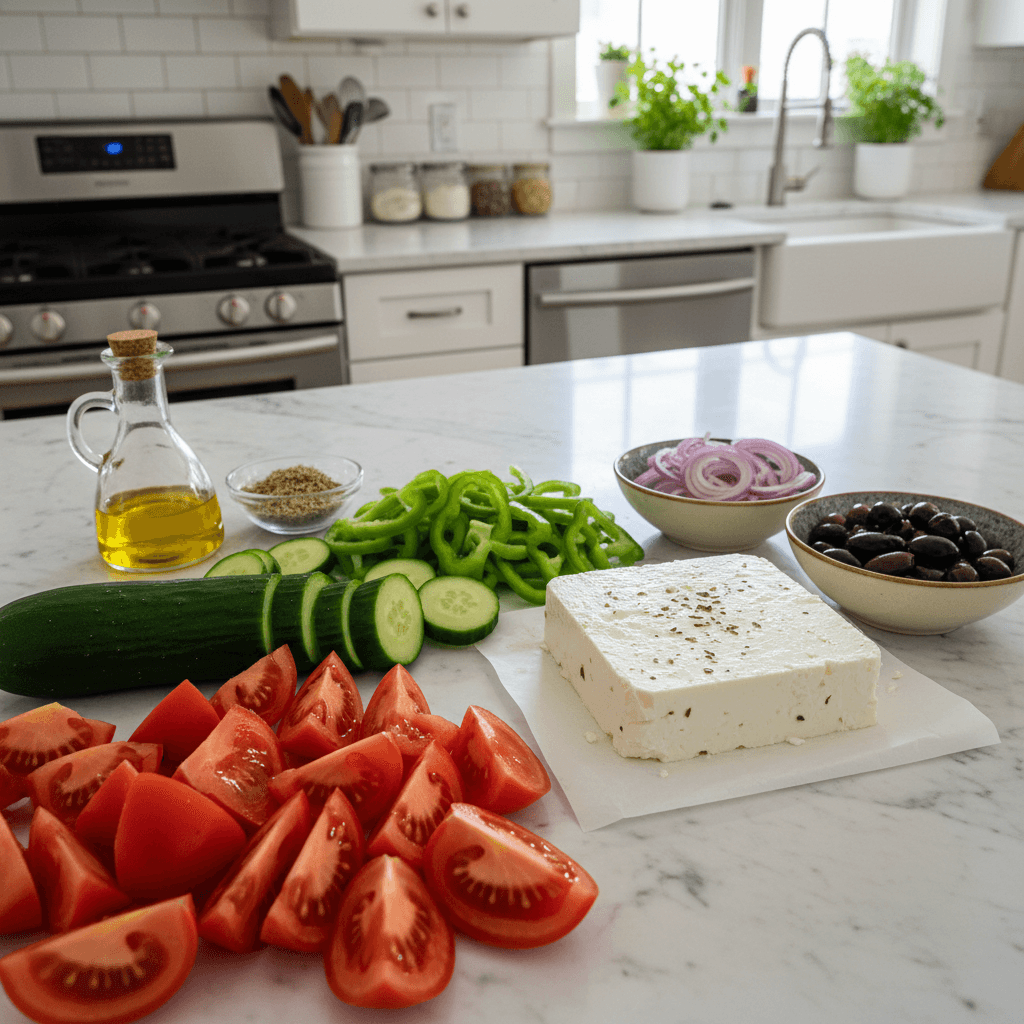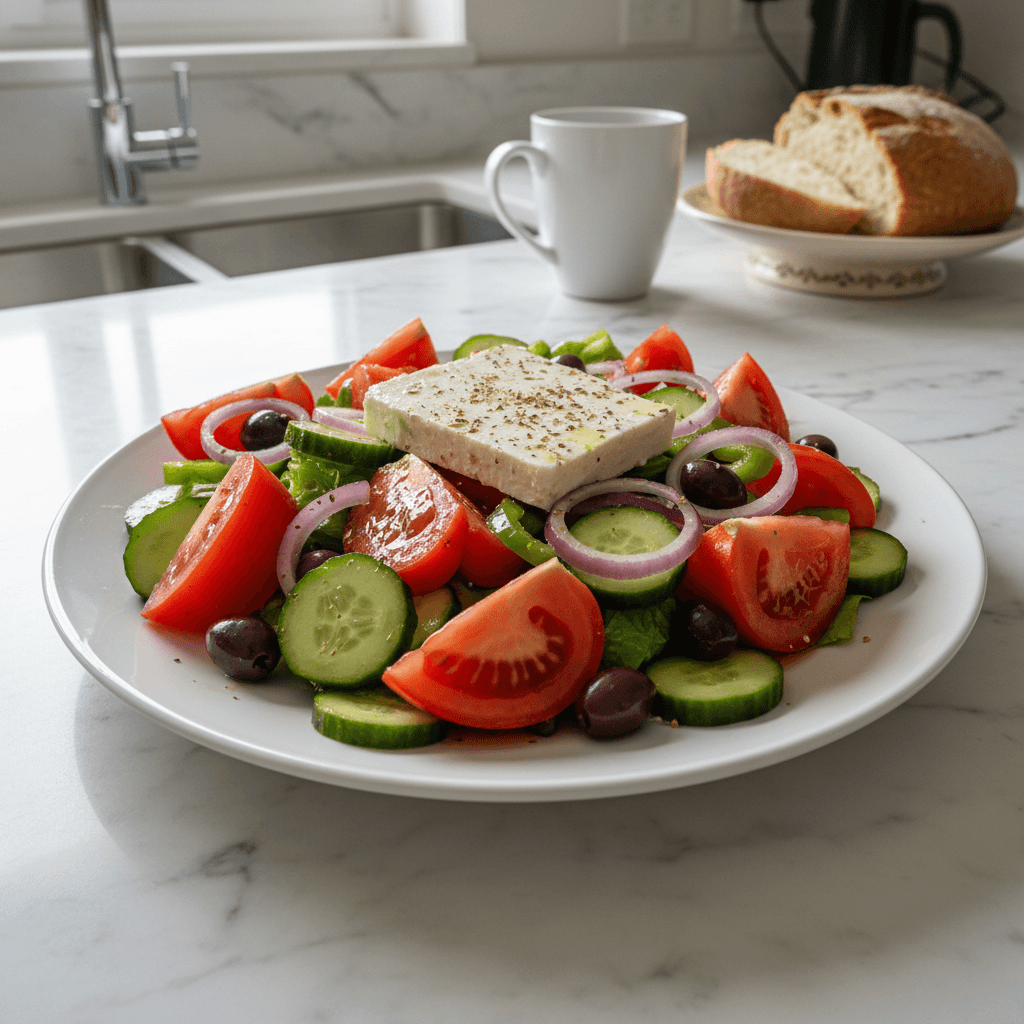I still remember the first time I tasted a proper Traditional Greek Village Salad. It wasn’t in Greece, sadly, but at a little family-run restaurant down the street from my first apartment. I was trying to cook more, you know, adulting and all, and their menu just had this photo of vibrant tomatoes and crisp cucumbers. I honestly didn’t expect much, just a side salad, but oh my goodness, it was an explosion of fresh flavors! It felt like sunshine and salt air, even on a gloomy Tuesday. That moment sparked something in me, it showed me how simple, good ingredients could create something truly special and comforting. It’s been a staple in my kitchen ever since, a little edible vacation.
One time, I was so excited to make this Traditional Greek Village Salad for a potluck, I completely forgot to deseed the cucumbers. Oops! My friend, bless her heart, gently pointed out the watery mess at the bottom of the bowl. I just laughed, honestly, that’s my kitchen for you always an adventure. But even with that little mishap, everyone still raved about the fresh flavors. It just goes to show, sometimes even a little imperfection can’t dim the deliciousness of good food.
Ingredients for Traditional Greek Village Salad
- Ripe Tomatoes (any kind, I often mix cherry and Roma): These are the heart of the salad! You want them juicy and flavorful. Don’t use those pale, sad grocery store tomatoes, just don’t. I swear by farmers market finds for that true sun-ripened taste.
- English Cucumber (or Persian): For that crisp, cool crunch. I always deseed mine now, especially if it’s a big one, after that potluck incident it really helps keep the salad from getting watery. A regular cucumber works too, just peel it if the skin is thick.
Red Onion (thinly sliced): Gives a lovely sharp bite and beautiful color. I usually soak mine in a little ice water for 10 minutes first, it mellows the harshness, which is a trick I learned that actually works. More garlic, less onion bite, that’s my mantra sometimes.
Green Bell Pepper (thinly sliced or chopped): Adds a fresh, slightly bitter note that balances the sweetness of the tomatoes. I once tried a yellow bell pepper, and it was… fine, but the green just hits different here, trust me.
Kalamata Olives (pitted, of course): These salty, briny gems are non-negotiable for a truly authentic feel. I prefer whole olives that I pit myself, the flavor is just better, though sometimes I’m lazy and buy them pre-pitted, shhh.
- Block Feta Cheese (Greek, if you can find it!): This is where the magic happens! Not the crumbled stuff in a tub, please. Get a block of good quality feta, preferably sheep or goat’s milk, and crumble it by hand right over the salad. It’s creamy, salty, and just melts in your mouth.
- Extra Virgin Olive Oil (good quality): The lifeblood of this salad. Don’t skimp here! A fruity, slightly peppery olive oil ties everything together. I’ve tried cheaper oils, and honestly, the salad just tasted flat.
- Red Wine Vinegar: Just a splash for that essential tang. It brightens everything up. I once accidentally used balsamic, and while it wasn’t awful, it totally changed the profile, it was a little too sweet.
- Dried Oregano (Greek, if possible): This herb is crucial. It adds that earthy, aromatic flavor that screams Mediterranean. I rub it between my palms before sprinkling to release its oils, it really makes a difference.
- Sea Salt & Freshly Ground Black Pepper: To taste, always. Don’t be shy with the salt, it brings out all the other flavors. I always add more pepper than a recipe calls for, it’s just how I roll.
Crafting Your Traditional Greek Village Salad
- Prep Your Veggies:
- First things first, get all those beautiful vegetables ready! I usually start with the tomatoes I like to cut them into rustic wedges, not too small, you know? Then, the cucumber gets halved lengthwise, deseeded with a spoon (trust me on this one!), and sliced into chunky half-moons. The red onion, oh the red onion, I slice it super thin, almost paper-thin, and sometimes give it a quick ice bath to soften its bite. And the green bell pepper? Just slice it into lovely rings or thin strips. I love seeing all those vibrant colors coming together on my cutting board, it’s like a little art project before dinner.
- Assemble the Base:
- Now for the fun part! Grab your biggest, prettiest salad bowl. I usually start by gently tossing the chopped tomatoes, cucumber, red onion, and green bell pepper together. This is where I always forget to add the olives first, oops! But no biggie, just toss them in later. You want to make sure everything is mixed well, but not bruised, so be gentle. I sometimes use my hands for this, it just feels more connected to the food, and honestly, it’s easier to feel if everything is coated evenly. Avoid over-mixing, we want distinct pieces, not a mushy mess.
- Add the Olives & Feta:
- Next up are those gorgeous Kalamata olives. Just scatter them generously over your veggie mix. And then, the star of the show: the feta! I grab my block of good Greek feta and just crumble it right over the top with my fingers. Seriously, don’t cut it, crumble it! It gives it that rustic, authentic feel. I love how the salty, creamy feta contrasts with the crisp veggies, it’s just a flavor explosion. Sometimes I even add a little extra feta for myself, because why not?
- Whip Up the Dressing:
- This dressing is ridiculously simple, which is what I adore about this Traditional Greek Village Salad. In a small bowl or even a measuring cup, I pour in a generous amount of good quality extra virgin olive oil. Then, a splash of red wine vinegar don’t overdo it, we want balance! A good pinch of sea salt and a generous grind of fresh black pepper. And finally, the dried oregano. I always rub it between my palms before sprinkling it in, it releases all those lovely aromatic oils. Whisk it all together until it’s slightly emulsified. I once forgot the oregano, and the dressing just wasn’t the same, trust me.
- Dress and Serve:
- Now for the grand finale! Pour that beautiful golden dressing all over your assembled salad. I usually give it a gentle toss again, just enough to coat everything without making a soggy mess. You want the veggies to still have their bite and the feta to remain mostly intact. The smell at this stage is just incredible fresh, herbaceous, and tangy. This is the part where my kitchen sometimes gets a little messy with olive oil drips, but hey, that’s part of the charm, right? Serve it immediately, it’s honestly best when everything is super fresh.
- Final Flourish:
- Before serving, I always give it one last sprinkle of dried oregano right on top, and maybe another crack of black pepper if I’m feeling fancy. The final result should look incredibly vibrant and inviting a true feast for the eyes before you even take a bite. The flavors meld together perfectly, delivering that authentic taste of a Traditional Greek Village Salad. It’s a simple dish, but it’s truly unforgettable, and it always makes me feel like I’m sitting by the Aegean Sea.
Making this salad always brings a smile to my face. It’s one of those dishes that just feels good, you know? There’s a certain rhythm to chopping the veggies, smelling the oregano, and then seeing it all come together. Even when my kitchen counter is covered in stray tomato seeds and olive oil drips, the end result is always so bright and satisfying. It’s a little piece of sunshine on a plate, and it often reminds me of happy, carefree days.

Ingredient Substitutions for Traditional Greek Village Salad
Life happens, and sometimes you don’t have every single ingredient for a Traditional Greek Village Salad. I get it! I’ve definitely had my fair share of “I’ll just use what’s in the fridge” moments. For the tomatoes, honestly, any ripe, flavorful tomato works. Heirloom tomatoes add a gorgeous color, though the texture might be a little softer. If you’re out of red wine vinegar, a squeeze of fresh lemon juice is a decent stand-in, but it does give a brighter, less mellow tang. I tried white wine vinegar once, and it worked… kinda, but it lacked the depth. As for the olives, while Kalamata are king, good quality black or even green olives can work in a pinch, just expect a different flavor profile. And if you’re dairy-free, a good plant-based feta alternative can sometimes do the trick, though the texture might vary. Just remember, these swaps change the classic vibe, but sometimes you just gotta make it work!
Serving Suggestions for Traditional Greek Village Salad
This Traditional Greek Village Salad is so versatile, it’s honestly amazing! For me, it’s the ultimate sidekick to grilled chicken or fish the freshness just cuts through the richness beautifully. It’s also fantastic with a simple pita bread, maybe some hummus or tzatziki, for a light and satisfying lunch. I love serving it alongside some homemade spanakopita, it’s a match made in heaven! And for a truly cozy night in, I’ll pair it with a glass of crisp white wine and a good rom-com. Yes please! It’s also surprisingly good with a hearty lentil soup on a cooler evening. The tang and freshness really brighten up a heavier meal. Whether it’s a casual backyard BBQ or a quick weeknight dinner, this salad fits right in.
Cultural Backstory of Traditional Greek Village Salad
The Traditional Greek Village Salad, or Horiatiki Salata as it’s known in Greece, isn’t just a salad, it’s a reflection of Greek culture and its deep connection to fresh, local produce. It’s a dish born from necessity and abundance, using the simple, sun-drenched ingredients readily available in any Greek village. There’s no lettuce in a true Horiatiki because, historically, lettuce wasn’t a common crop in much of Greece. It’s all about those robust, seasonal vegetables picked at their peak. For me, discovering this salad felt like uncovering a little secret from a distant, sun-drenched land. It’s more than just food, it’s a taste of history, a nod to generations of home cooks who knew how to make something truly extraordinary from humble ingredients. Every time I make it, I feel a connection to that rich culinary heritage, and it makes the salad taste even better.
So there you have it, my take on the beloved Traditional Greek Village Salad. It’s a dish that holds so many memories for me, from that first bite to all the little kitchen adventures along the way. It always turns out so beautifully, a testament to simple, fresh ingredients. I hope it brings a little bit of that Mediterranean sunshine into your home too. Give it a try, play with it, make it your own, and don’t forget to tell me your kitchen stories!

Traditional Greek Village Salad FAQs
- → Can I add other vegetables to this Greek Village Salad?
While a true Traditional Greek Village Salad sticks to the core ingredients, I’ve definitely thrown in some thinly sliced radishes or even some capers for an extra pop. It changes the classic profile a bit, but honestly, sometimes it’s fun to experiment!
- → What if I don’t have fresh oregano for the Traditional Greek Village Salad?
The recipe actually calls for dried oregano, which is more traditional for this salad! If you only have fresh, you’d need about a tablespoon, finely chopped, but dried really gives it that authentic, earthy punch. I tried fresh once, and it was okay, but I prefer dried for this dish.
- → How do I prevent my Traditional Greek Village Salad from getting watery?
Ah, the watery salad dilemma! My main trick is to deseed the cucumber. Also, don’t dress the salad until right before serving, and make sure your tomatoes are ripe but firm, not overly soft. That’s usually where I go wrong!
- → Can I make the dressing for the Traditional Greek Village Salad ahead of time?
Absolutely! I often whisk up a batch of the dressing and keep it in a sealed jar in the fridge for up to a week. Just give it a good shake or re-whisk before using, as the oil and vinegar might separate. It’s a real time-saver!
- → What’s the best type of feta cheese for this Traditional Greek Village Salad?
For the best flavor and texture, I always recommend using a block of authentic Greek feta cheese, usually made from sheep or goat’s milk, packed in brine. It crumbles beautifully and has a richer, creamier taste than the pre-crumbled stuff. Trust me on this one!

Traditional Greek Village Salad: Fresh, Tangy, & Simple
- Prep Time: 15 Minutes
- Cook Time: 0 Minutes
- Total Time: 15 Minutes
- Yield: 4 Servings
- Category: AllRecipes
Description
Traditional Greek Village Salad: Your authentic taste of Greece! Crisp veggies, salty feta, and rich olive oil create a simple, vibrant dish youll love.
Ingredients
- Fresh Market Finds:
- Ripe Tomatoes (any kind, I often mix cherry and Roma)
- English Cucumber (or Persian, deseeded)
- Red Onion (thinly sliced)
- Green Bell Pepper (thinly sliced or chopped)
- The Salty, Tangy Bits:
- Kalamata Olives (pitted)
- Block Feta Cheese (Greek, if you can find it!)
- Golden Dressing Essentials:
- Extra Virgin Olive Oil (good quality)
- Red Wine Vinegar
- Flavorful Sprinkles:
- Dried Oregano (Greek, if possible)
- Sea Salt
- Freshly Ground Black Pepper
Instructions
- Prep Your Veggies:: First things first, get all those beautiful vegetables ready! I usually start with the tomatoes – I like to cut them into rustic wedges, not too small, you know? Then, the cucumber gets halved lengthwise, deseeded with a spoon (trust me on this one!), and sliced into chunky half-moons. The red onion, oh the red onion, I slice it super thin, almost paper-thin, and sometimes give it a quick ice bath to soften its bite. And the green bell pepper? Just slice it into lovely rings or thin strips. I love seeing all those vibrant colors coming together on my cutting board; it’s like a little art project before dinner.
- Assemble the Base:: Now for the fun part! Grab your biggest, prettiest salad bowl. I usually start by gently tossing the chopped tomatoes, cucumber, red onion, and green bell pepper together. This is where I always forget to add the olives first, oops! But no biggie, just toss them in later. You want to make sure everything is mixed well, but not bruised, so be gentle. I sometimes use my hands for this, it just feels more connected to the food, and honestly, it’s easier to feel if everything is coated evenly. Avoid over-mixing; we want distinct pieces, not a mushy mess.
- Add the Olives & Feta:: Next up are those gorgeous Kalamata olives. Just scatter them generously over your veggie mix. And then, the star of the show: the feta! I grab my block of good Greek feta and just crumble it right over the top with my fingers. Seriously, don’t cut it, crumble it! It gives it that rustic, authentic feel. I love how the salty, creamy feta contrasts with the crisp veggies; it’s just a flavor explosion. Sometimes I even add a little extra feta for myself, because why not?
- Whip Up the Dressing:: This dressing is ridiculously simple, which is what I adore about this Traditional Greek Village Salad. In a small bowl or even a measuring cup, I pour in a generous amount of good quality extra virgin olive oil. Then, a splash of red wine vinegar – don’t overdo it, we want balance! A good pinch of sea salt and a generous grind of fresh black pepper. And finally, the dried oregano. I always rub it between my palms before sprinkling it in; it releases all those lovely aromatic oils. Whisk it all together until it’s slightly emulsified. I once forgot the oregano, and the dressing just wasn’t the same, trust me.
- Dress and Serve:: Now for the grand finale! Pour that beautiful golden dressing all over your assembled salad. I usually give it a gentle toss again, just enough to coat everything without making a soggy mess. You want the veggies to still have their bite and the feta to remain mostly intact. The smell at this stage is just incredible – fresh, herbaceous, and tangy. This is the part where my kitchen sometimes gets a little messy with olive oil drips, but hey, that’s part of the charm, right? Serve it immediately; it’s honestly best when everything is super fresh.
- Final Flourish:: Before serving, I always give it one last sprinkle of dried oregano right on top, and maybe another crack of black pepper if I’m feeling fancy. The final result should look incredibly vibrant and inviting – a true feast for the eyes before you even take a bite. The flavors meld together perfectly, delivering that authentic taste of a Traditional Greek Village Salad. It’s a simple dish, but it’s truly unforgettable, and it always makes me feel like I’m sitting by the Aegean Sea.










